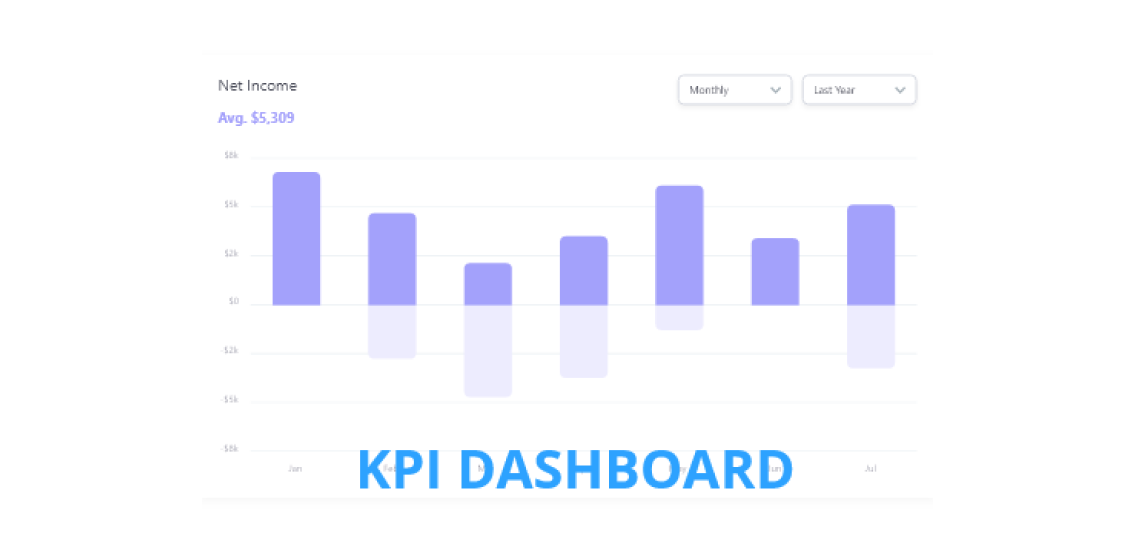
What is KPI dashboard ?
Every system is consist of many key elements and performance of each element will determine the output of the system as well as the performance measure.
So if we consider a business as the system and whose performance is affected by the lots of process and activities. To be aware of how your business is doing, we need real-time reporting and a quick overview of every department’s performance.
A KPI tracking dashboard collects, groups, organises and visualises the company’s important metrics, providing a quick overview of business performance and expected growth.
There are some indicators of the KPI which indicate the business performance which are as follows:
- Revenue growth rate
- Net profit
- Project schedule variance (PSV) (are projects completed in time)
- Churn rate (how many people stop using the product or service)
- Average revenue for each customer
- Customer lifetime value (CLV/LTV)
Why business needs KPI dashboard?
Every business need a KPI dashboard to measure its performance and to look after the different process and activity going on in day to day business.
The KPI dashboard helps in following ways which are as follows:
- KPI tracking dashboard displays an organization’s key performance indicators and is beneficial in many ways.
The greatest value of a modern business dashboard lies in its ability to provide real-time information about a company’s performance. As a result, business leaders, as well as project teams, are able to make informed and goal-oriented decisions, acting on actual data instead of gut feeling.
- Moreover, a timely and well-framed KPI dashboard helps to instantly notice problem areas and tackle the problems.
Managers that use KPI dashboards daily for getting a quick overview know where to focus their energy and realise if there’s a need to improve any poorly performing process.The KPIs on a dashboard are chosen and organised according to the user’s needs.
- Manage your supply chain
Logistics can become a real burden if we don’t use a supply chain KPI software. Fortunately, there are a lot of different programs and apps available that let us to measure inventory to sales ratio, track order statuses and see what the inventory turnover currently is. Advanced systems let us to see a map overview of all orders, so we can track as they move across the world. Innovative solutions will help you in supply chain management beyond any expectations.
- You’ll get an integrated overview
That’s right. One of the main reasons to invest in KPI software is integration. As we might have understood earlier, the data flow from different sources is a huge headache if no integrational methods are applied. Using KPI software allows all your departments to enter their data manually into one big system, or the program can connect to different data flows automatically. Whichever choice is picked, you can be sure that the integrated connection will boost your business management.
- Enhance your retail business management
Retail business is a heaven for KPI usage as the buying-selling of goods generates a generous amount of data that can be analyzed. A typical retail KPI dashboard includes customer retention, average purchase value, sales per square meter, and customer satisfaction. Many metrics can be combined to come up with unique indicators that will help you develop your retail business.
- Increase marketing team success
Marketing is all about measuring the return on investment for promotional activities and advertising. But nowadays, marketing managers don’t look only at the traditional metrics. Using a KPI dashboard for marketing means that you might measure newsletter signup conversion rate, brand awareness, sessions by device type, and content downloads among other key performance indicators. The particular marketing metrics really depend on your company. For some, content download rate is the absolute key indicator for success. Others might base their marketing decisions on the fluctuations of customer lifetime value (LTV).
- Regain control over company’s finances
Revenue management and financial leadership are absolutely essential to any business. Having an overview of financial key performance indicators is easy when you use the right software. Even people and institutions outside of your organization are interested in knowing about the situation concerning finances. Investors, tax authorities, and stockholders demand to see your financial KPIs. Among other things, you can use a KPI dashboard to have a solid overview of inventory turnover, return on equity, and net profit margin.
Different kind of business which needs KPI dashboard
There are different kind of business organization which needs KPI dashboard which are as follows:
- Customer service based organization
- Finance based organization
- Accommodation and Food Services Industry
- Waste Management and Remediation Services Industry.
- Agriculture, Forestry, Fishing, and Hunting Industry
- Arts, Entertainment, and Recreation Industry
- Construction Industry
- Educational Services Industry
- Health Care and Social Assistance Industry
- Information Industry
- Management of Companies and Enterprises Industry
- Manufacturing Industry
- Professional, Scientific, and Technical Services
- Real Estate and Rental and Leasing Industry
- Transportation and Warehousing Industry
- Wholesale Trade Industry
- Retail Trade Industry
Features of KPI dashboard
The effective dashboard can make the business to run in proper manner and the management is able to analyze the outcomes very easily. Some basic features of the KPI dashboard are as follows:
Simplicity:For a KPI to be truly helpful it needs to be simple in two ways. It needs to be both easily comprehended and measured. For example, a KPI such as “how many clients did we add this month” is simple in both ways. Business analytics expert Jay Liebowitz says that an effective KPI is one that “prompts decisions, not additional questions.” Each staff member involved in a goal should know exactly how to effect a KPI. If the goal is clear, such as “add more clients,” staff can make proactive decisions to influence the outcome. Additionally, a simple question like client acquisition is simple to gather. You want a KPI that will raise the overall visibility of the campaign without disrupting daily operations.
Aligned:Effective KPIs “cascade from strategic dashboards to tactical and operational dashboards,” according to a Data Warehousing Institute metrics report. This simply means that KPIs should trickle down from the overall strategic goals of an organization to the daily operations of the staff that are affecting them. While some organizations focus on gaining an ever-growing amount of clients, for other other businesses, this may not align with the overall vision. For example, a business that centers on customer service would have a more central focus on customer retention than acquisition. Make sure that KPIs are always aiding the umbrella goals of the organization.
Relevant:Another one of the characteristics of an effective KPI is relevance, meaning that the appropriate decision makers are in control of affecting specific KPIs. For example, a KPI that asks “how many products did we sell during our sampling event” should be the responsibility of the marketing manager. By assigning the responsibility of the KPI to the relevant manager, the measurement will be more educated and the results will be more successful.
Measurable:To analyze positive and negative variations from a goal, a KPI must be measurable. This does not always need to be qualitative measurement such as “how many products did we sell last month,” but can also be qualitative such as “how engaged are employees with their work.” The latter can be determined with standardized surveys created through custom forms, even though its subjective nature isn’t numerical. Always ensure that your KPI is based on a solid, focused goal such as sales, marketing, or customer satisfaction. An effective KPI avoids generalized questions like “Improvement in field operations.”
Achievable:The National Federation of Independent Business (NFIB) ranks setting “unachievable goals” as one of the biggest employee de-motivators. KPIs must be set with goals that employees feel they can reach. The more realistic the goal of a KPI is, the more likely employees are to reach it. Instead of setting large, seemingly unattainable goals, start small. For example, set monthly goals that employees will be challenged, but not overwhelmed by. By having closer deadlines and smaller goals, the organization can attain the overall growth it aspires to.
Timely:Effective KPIs are timely in two ways: Their results are reported on an appropriate timeline, and are analyzed in a relevant time period. Businesses must find a happy medium with reporting on KPI results. Infrequent reports will create difficulty in accurately identifying trends, while reporting too frequently can diminish the value of the collected data. To determine the appropriate frequency of your reports, consider the sensitivity, urgency, cost, and accuracy of the proposed timeline. Additionally, ensure that the results of the report are being acted on in a timely manner. For example, analyzing data from an isolated month in the previous year would not be a good benchmark for your next month in the current year.
Visible:Another of the essential characteristics of an effective KPI is its visibility across the entire organization. Growth is achieved more easily when all employees are engaged and aware of the organization’s goals. While there may be parts of the organization that will not actively participate in effecting a particular KPI, making the goal visible will increase employee engagement and set a standard for accountability on future projects. Key Performance Indicators are an excellent way to measure the success of organizational and individual goals and these seven characteristics will encourage their success and longevity in any organization.
How Ahex helps business having KPI dashboard ?
Ahex Technologies is one of the leading company in providing solutions in the domains of Data Visualization, Data Analytics, ERP’s, IOT and Blockchain. Ahex Technologies focuses on offshore outsourcing, by providing innovative and quality services and value creation for clients.
Ahex helps in development of different types KPI dashboard as per the requirement as Ahex supports following qualities which are as follows:
- Effective team: Ahex provide constant support with the effective team in development process of the KPI dashboard with maintenance of it. Ahex provide end to end development process with least error possibility and with effective time management.
- Favourable technology: Ahex team adopts the most advanced technology which make the KPI more favourable for the client to interpret.
- Database maintenance: The client data which has certain criticality level are perfectly maintained by the Ahex team with highly secure based techniques. In this case the KPI become more secured for the client.
- Real time support: Ahex provide real time support for the KPI maintenance and in every process which ever related with the development of KPI and upgradation of it.








